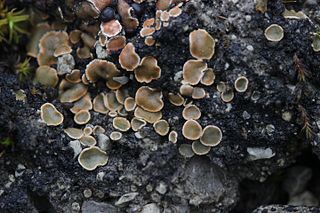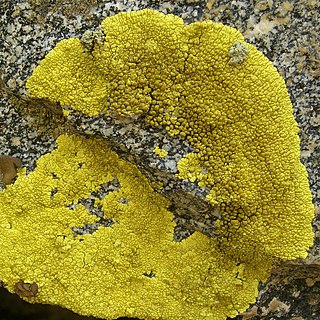
Psora is a genus of lichen-forming fungi in the family Psoraceae. Members of the genus are commonly called fishscale lichens. Lichens in the genus Psora generally have a squamulose thallus and anthraquinones in the hymenium. Photobiont partners of Psora lichens include members of the green algal genera Asterochloris, Chloroidium, Myrmecia, and Trebouxia.

The Arthoniaceae are a family of lichenized, lichenicolous and saprobic fungi in the order Arthoniales. The Arthoniaceae is the largest family of Arthoniales, with around 800 species. Most species in Arthoniaceae belong in Arthonia which is the largest genus with 500 species. The second and third largest genus is Arthothelium with 80 species, and Cryptothecia with 60 species.

The Pertusariales are an order of fungi in the class Lecanoromycetes, comprising 8 families, 31 genera, and over 600 species, many of which form lichens. This diverse group is characterized by complex taxonomic history and ongoing phylogenetic revisions. Originally proposed by Maurice Choisy in 1949 and later formally published by the lichenologists David L. Hawksworth and Ove Eriksson in 1986, Pertusariales has undergone significant reclassification due to molecular phylogenetics studies. The order includes well-known genera such as Pertusaria and Ochrolechia, as well as families like Megasporaceae and Icmadophilaceae.

Diploschistes is a genus of lichen-forming fungi in the family Graphidaceae. Commonly known as crater lichens, members of the genus are crustose lichens with a thick, cracked (areolate) body (thallus) with worldwide distribution. The fruiting part (apothecia) are immersed in the thick thallus so as to have the appearance of being small "craters". The widespread genus contains about 43 species.

Lecanactis is a genus of crustose lichens, commonly called old wood rimmed lichen. The genus was circumscribed in 1855 by German lichenologist Gustav Wilhelm Körber, who assigned Lecanactis abietina as the type species.

Phacopsis is a genus of lichenicolous (lichen-dwelling) fungi. They are parasites of members of the large lichen family Parmeliaceae, of which they are also a member. Originally proposed by Edmond Tulasne in 1852 to contain 3 species, Phacopsis now contains 10 species, although historically, 33 taxa have been described in the genus. Many of the species are poorly known, some of them having been documented only from the type specimen.

Pleopsidium is a genus of lichen-forming fungi in the family Acarosporaceae. The widespread genus, which contains four species, was circumscribed by lichenologist Gustav Wilhelm Körber in 1855.

Leptorhaphis is a genus of lichens in the family Naetrocymbaceae. Members of the genus Leptorhaphis are commonly called birchbark dot lichens.

Lecanographaceae is a family of mostly lichens in the order Arthoniales. The family was circumscribed in 2014, prompted by a molecular phylogenetic-based restructuring of the Arthoniales.

Massalongia is a genus of lichen-forming fungi in the family Massalongiaceae. It has four species. The genus was circumscribed by German lichenologist Gustav Wilhelm Körber in 1855, with M. carnosa assigned as the type species.

Schaereria is a genus of lichen-forming fungi. It is the sole genus in the family Schaereriaceae, which itself is the only family in the Schaereriales, an order in the subclass Ostropomycetidae of the class Lecanoromycetes. Most Schaereria species are crustose lichens that live on rocks. Schaereria was first proposed by Gustav Wilhelm Körber in 1855 and was later taken up by other lichenologists despite periods of disuse.

Sporastatia is a genus of crustose lichens in the family Sporastatiaceae. It has four species. Sporastatia lichens are long-lived species that grow on siliceous or weakly calcareous rocks in arctic and alpine locales.

Massalongiaceae is a small family of lichen-forming fungi in the order Peltigerales. It has three genera and seven species.
Harpidiaceae is a small family of lichen-forming fungi, containing two genera and five species. It is of uncertain classification in the Pezizomycotina.

Ludwig Emanuel Schaerer was a Swiss pastor and lichenologist. Interested in natural history from a young age, Schaerer trained as a teacher and studied theology in Bern. During his career as a teacher, orphanage director, and pastor, he researched extensively and maintained correspondence with foreign botanists interested in cryptogams. Schaerer was best known for his multi-volume work Lichenum Helveticorum Spicilegium, published in 12 parts from 1823 to 1842. This series catalogued and described the lichens of Switzerland, particularly those in the Alps, where he often went on collecting excursions. In another series, he compiled and distributed dried herbarium specimens acquired from his collections. Several lichen taxa have been named in honour of Schaerer.
Buellia subalbula is a species of saxicolous (rock-dwelling), crustose lichen in the family Caliciaceae. It occurs in coastal southern Africa, South America, and Australia, where it grows on calcareous rocks.
Teloschistes spinosus is a species of corticolous (bark-dwelling), fruticose lichen in the family Teloschistaceae. It is found in Australia and New Zealand.
Eremothecella cyaneoides is a species of foliicolous (leaf-dwelling) lichen in the family Arthoniaceae. Identified as a new species in 2001, it is a distinct species of leaf-dwelling lichen found in Queensland, Australia. This species is marked by its continuous or marginally dispersed, smooth, whitish-grey thallus. It hosts a phycobiont of the genus Phycopeltis, characterised by rectangular cells arranged in radiate rows.
Snippocia is a monospecific fungal genus in the family Arthoniaceae. It contains the single species Snippocia nivea, a crustose, corticolous (bark-dwelling) lichen. This lichen was previously known as Schismatomma niveum; Snippocia was established to accommodate the species after molecular studies indicated that it did not belong in its previously assigned genus.
Megaloblastenia is a genus of crustose lichen-forming fungi in the family Megalosporaceae, comprising three species. Proposed by Dutch lichenologist Harrie Sipman in 1983, the genus is characterised by its thick, ecorticate thallus ranging from pale whitish-grey to yellowish, and its disc-like fruiting bodies (apothecia) that can be biatorine or lecideine. Megaloblastenia lichens form a symbiotic relationship with Dictyochloropsis algae, produce hyaline, bicellular ascospores with polaribilocular structure, and contain chemical compounds such as zeorin, pannarin, or usnic acid. Found in Australasia and South America, these lichens typically grow as epiphytes on trees in moist forests within temperate to tropical oceanic climates.













